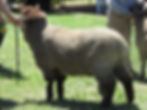Breeding Coloured Sheep.
These guidelines are designed to assist breeders of coloured sheep reach a standard of excellence in their flocks, and to appreciate what qualities a judge will be looking for when sheep are presented in a show ring. To achieve this, it is important to set ourselves a high standard when we begin breeding, and to have a clear vision of what we are aiming for.
















Aims.
To show sheep (and fleeces) which are of a high standard, and possess winning potential.
To show sheep and fleeces which, when sold, will benefit the buyer and not reflect badly on us, the producers.
To enhance the reputation of the coloured sheep industry by presenting such good quality sheep that when white sheep breeders see them on exhibition at shows, etc., they will recognise, (even if somewhat reluctantly), that they are worthy to be there. It is only when we pay attention to good breeding that we will make any real progress.
Financial profit.
















How to achieve this.
Perhaps an important point to remember is to be one’s own hardest critic, and to keep sentimentality to a minimum when assessing our sheep.
Unless breeding for the skin trade, avoid the short wool meat sheep breeds such as the Dorset, Southdown or Suffolk… they are not wool growers.
Use the very best ram possible for sires, preferably pure bred rams. It is more important to have a good ram and maybe a mediocre ewe than vice versa, although it is important that ewes are structurally sound. Too many crosses of breed in the one sheep and in-breeding will ultimately produce inferior stock, with the high likelihood of conformation and wool faults.
Keep it firmly in mind that to grow a top quality fleece, it is necessary to have a top quality sheep on which to grow it, and that the main market outlet is the handcraft trade.

















